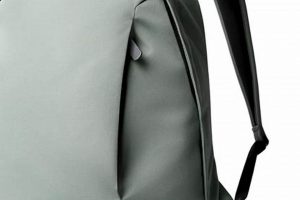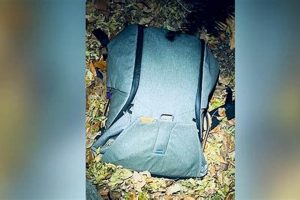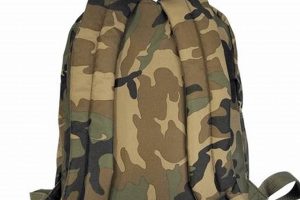A specialized carrying solution designed for basketball players, prioritizes organization, durability, and functionality. These bags often feature dedicated compartments for items such as basketballs, shoes, water bottles, and electronic devices, protecting valuable gear and facilitating easy access. One might observe athletes carrying such a bag at a practice session or game.
The importance of a well-designed carrier for sports equipment lies in its ability to streamline preparation and recovery. Benefits include safeguarding expensive athletic shoes, preventing the compression of uniforms, and maintaining hydration by keeping drinks cold. Historically, makeshift bags or simple gym bags were common; however, as sports became more specialized, the need for tailored storage solutions emerged.
The following discussion will delve into specific features, material considerations, size variations, and design innovations related to specialized athletic bags. It will also touch upon price points and factors influencing purchasing decisions, as well as a comparison of leading brands and models currently available.
Tips for Selecting a Premium Basketball Backpack
The selection of appropriate athletic equipment is crucial for optimal performance and longevity. Careful consideration should be given to the attributes of such items to ensure they meet the demands of rigorous use.
Tip 1: Prioritize Durable Materials: Ballistic nylon or high-denier polyester are recommended materials due to their abrasion resistance and ability to withstand frequent use. Examine stitching and reinforcements at stress points.
Tip 2: Evaluate Compartment Organization: Dedicated compartments for footwear, apparel, and hydration are essential. A separate, ventilated shoe compartment prevents odor transfer and protects other contents.
Tip 3: Assess Ball Carrying Capacity: The ability to securely transport a regulation-size basketball is paramount. External net pockets or internal cradles designed for this purpose should be evaluated for stability and accessibility.
Tip 4: Consider Ergonomic Design: Padded shoulder straps and a breathable back panel are crucial for comfort during transport, particularly when carrying heavy loads. A sternum strap enhances stability and reduces strain.
Tip 5: Investigate Water Resistance: Water-resistant coatings or materials are advisable to protect contents from moisture damage, especially in variable weather conditions. Sealed zippers offer additional protection.
Tip 6: Examine Closure Mechanisms: Heavy-duty zippers and secure buckles are necessary for reliable closure and prevention of accidental opening. Consider zippers with large pulls for ease of use with gloved hands.
Tip 7: Check for External Attachment Points: Webbing loops or D-rings provide options for attaching additional equipment, such as carabiners or clip-on accessories. This increases carrying capacity and versatility.
Proper selection of an athletic carrier requires careful evaluation of its materials, organization, ergonomics, and protective features. Attention to these details will ensure the chosen bag meets the athlete’s specific needs and withstands the rigors of training and competition.
The following section will explore specific brands and models that exemplify these key features, providing a comparative analysis for informed purchasing decisions.
1. Durability
Durability constitutes a pivotal attribute in any carrying solution intended for athletic use, particularly those designed for basketball. The capacity of an elite basketball backpack to withstand the stresses of frequent use and diverse environmental conditions directly impacts its lifespan and overall value.
- Material Strength and Resistance
The selection of high-tenacity fabrics, such as ballistic nylon or ripstop polyester, forms the foundation of a durable athletic bag. These materials exhibit superior resistance to abrasion, tearing, and puncture, safeguarding contents from external damage during transport and storage. The use of reinforced stitching at stress points further enhances structural integrity.
- Component Quality and Longevity
Zippers, buckles, and straps represent critical components susceptible to wear and tear. The utilization of heavy-duty zippers with robust teeth and durable sliders, as well as high-quality buckles crafted from impact-resistant polymers, ensures reliable closure and prevents premature failure. Reinforced stitching around attachment points secures straps and handles, mitigating the risk of detachment under heavy loads.
- Weather Resistance and Protection
Exposure to moisture and the elements can compromise the integrity of equipment and accessories stored within a basketball backpack. Water-resistant coatings or laminated fabrics repel water, preventing saturation and potential damage to contents. Reinforced bottom panels protect against abrasion and moisture penetration when the bag is placed on the ground.
- Construction Integrity and Reinforcement
Beyond the materials themselves, the overall construction quality significantly impacts the bag’s durability. Double-stitched seams, reinforced corners, and strategically placed padding provide added protection and structural support. A well-constructed frame helps maintain the bag’s shape and prevents sagging, even when fully loaded.
The interplay of these facets dictates the overall durability of a specialized athletic carrier. Superior materials, high-quality components, weather resistance, and robust construction collectively contribute to a product designed to endure the rigors of athletic training and competition, representing a worthwhile investment for serious basketball players.
2. Organization
Efficient organization within a specialized athletic carrier significantly contributes to streamlined preparation and optimized performance. The arrangement of compartments and specialized features directly impacts a user’s ability to quickly access and manage equipment, thereby enhancing the overall training and game-day experience.
- Dedicated Shoe Compartment
A designated, ventilated shoe compartment separates footwear from clean apparel, preventing odor transfer and potential soiling. This compartment often features durable, easy-to-clean materials to withstand the accumulation of dirt and debris. The presence of a separate shoe compartment minimizes the risk of contaminating other items, such as uniforms or personal electronics.
- Ball Compartment
A secure, readily accessible ball compartment is a defining characteristic. Whether integrated into the main compartment or externally mounted, this feature ensures stable transport of a regulation-size basketball. Padded or reinforced construction minimizes the risk of abrasion to the ball’s surface during transit, maintaining its condition and performance.
- Accessory Pockets and Dividers
Strategically positioned accessory pockets and dividers facilitate the organization of smaller items, such as water bottles, keys, wallets, and electronic devices. Internal mesh pockets provide visibility and prevent items from shifting during movement. The presence of specialized compartments for tablets or smartphones protects sensitive electronics from impact and scratches.
- Wet/Dry Compartment
A waterproof or water-resistant compartment segregates wet or soiled items from clean gear, preventing moisture transfer and odor contamination. This feature is particularly useful for storing post-workout apparel, damp towels, or swimwear. Sealed seams and durable closures ensure the integrity of the compartment, preventing leakage and maintaining hygiene.
These organizational elements, when thoughtfully integrated into the design, elevate a standard carrying solution to a specialized tool that directly supports an athlete’s preparedness and efficiency. The ability to quickly locate and access specific items minimizes distractions and allows athletes to focus on training and competition.
3. Comfort
Comfort represents a crucial design consideration in athletic carrying solutions, impacting the user’s experience and overall utility of the product. The manner in which an elite basketball backpack distributes weight, mitigates pressure points, and promotes breathability determines its suitability for extended use and demanding conditions.
- Padded Shoulder Straps and Ergonomic Design
Shoulder straps constructed with dense, closed-cell foam and contoured to follow the natural curvature of the shoulders distribute weight evenly, reducing pressure and preventing discomfort. Ergonomic design principles, such as strategically placed padding and adjustable straps, optimize the fit and minimize strain on the neck and back. Wide shoulder straps further enhance comfort by increasing the surface area in contact with the body, dispersing the load more effectively. Example: A player walking long distances to a game benefits from well-padded straps.
- Breathable Back Panel Construction
Back panels incorporating ventilated mesh or channeled foam promote airflow, reducing heat and perspiration buildup during periods of activity. These designs minimize contact between the bag and the user’s back, further enhancing breathability and preventing moisture accumulation. Example: A mesh back panel will help dissipate heat during warm weather conditions when going to workout.
- Adjustable Sternum Strap and Waist Belt
A sternum strap connects the shoulder straps across the chest, stabilizing the bag and preventing it from shifting during movement. A waist belt transfers a portion of the bag’s weight to the hips, reducing strain on the shoulders and back. These adjustable straps allow for a customized fit, accommodating different body types and load distributions. Example: When running, both straps will help keep the balance.
- Lightweight Materials and Construction
The overall weight of the carrier significantly impacts user comfort, particularly when carrying heavy loads for extended periods. Utilizing lightweight materials, such as ripstop nylon or lightweight polyester, minimizes the overall weight of the bag without compromising durability. Streamlined construction techniques further reduce weight by eliminating unnecessary bulk and components. Example: The lighter the bag, the easier it is to carry it around.
These comfort-enhancing design features collectively contribute to an elite basketball backpack that is not only functional and durable but also comfortable to wear, even when fully loaded. A well-designed athletic bag prioritizes user comfort to minimize fatigue and maximize performance.
4. Capacity
Capacity, in the context of an elite basketball backpack, refers to the internal volume and load-bearing capability of the bag, directly influencing its practicality and utility for athletes. Insufficient capacity restricts the ability to carry essential gear, while excessive capacity adds unnecessary bulk and weight, hindering mobility. The optimal balance ensures all necessary items, such as a basketball, shoes, apparel, hydration, and accessories, are accommodated without compromising comfort or maneuverability. For example, a player participating in a full-day tournament requires sufficient space for multiple changes of clothes, extra shoes, and nutritional supplements, demanding a larger capacity compared to a player attending a brief practice session.
The interplay between capacity and organizational features is critical. A well-designed bag will utilize its internal volume efficiently, incorporating dedicated compartments and dividers to prevent items from shifting and becoming disorganized. The placement and size of these compartments directly impact the accessibility of specific items. The ability to isolate wet or soiled clothing from clean gear, or to protect electronic devices from impact, depends on the effective management of capacity and internal arrangement. Furthermore, the external dimensions of the product, influenced by its capacity, must remain within reasonable limits to comply with airline carry-on restrictions or locker size constraints.
In conclusion, capacity is a defining characteristic of specialized athletic bags. The practical significance of understanding capacity lies in the ability to select a product that meets the specific storage requirements of the user. Balancing volume, organizational features, and external dimensions ensures the selected carrier effectively supports the athlete’s needs without compromising comfort or convenience, ultimately contributing to enhanced preparation and performance. However, challenges remain in standardizing capacity measurements and accounting for the varying shapes and sizes of athletic gear.
5. Protection
In the context of an elite basketball backpack, protection refers to the bag’s ability to safeguard valuable equipment from potential damage caused by external elements, impacts, or environmental factors. The protective features integrated into the design and materials of such a bag are paramount in ensuring the longevity and functionality of the carried items.
- Impact Resistance
Specialized athletic bags incorporate padding and reinforced panels to mitigate the effects of impacts during transport. This is particularly crucial for protecting delicate items like electronic devices or fragile athletic accessories. For instance, a padded laptop sleeve or a hard-shell compartment for sunglasses provides additional cushioning against accidental bumps and drops. The implications of effective impact resistance extend to minimizing repair or replacement costs associated with damaged equipment.
- Weatherproofing and Water Resistance
Exposure to moisture can compromise the integrity of various athletic items, including apparel, footwear, and electronic devices. Therefore, water-resistant materials and sealed zippers are often utilized to protect the bag’s contents from rain, spills, and humidity. A water-resistant coating on the exterior fabric prevents water from seeping into the bag, while sealed zippers provide an additional barrier against moisture intrusion. The absence of adequate weatherproofing measures can lead to water damage, mold growth, and corrosion of sensitive equipment.
- Scratch and Abrasion Resistance
The exterior of an elite basketball backpack is subjected to friction and abrasion during normal use. Durable materials, such as ballistic nylon or high-denier polyester, offer resistance to scratches and scuffs, preserving the bag’s aesthetic appearance and preventing premature wear. Reinforced corners and bottom panels further enhance abrasion resistance in high-contact areas. A bag lacking these features may quickly show signs of wear and tear, reducing its overall lifespan.
- Compartmentalization and Isolation
Strategic compartmentalization contributes to protection by preventing items from rubbing against each other and causing damage. Separate compartments for shoes, apparel, and electronic devices minimize the risk of scratches, dents, and other forms of wear. Additionally, dedicated compartments for wet or soiled items prevent moisture and odor transfer to clean gear. Effective compartmentalization not only enhances organization but also prolongs the lifespan of the equipment carried within the bag.
These protective features, when effectively implemented, enhance the overall value and utility of a specialized athletic carrier. From safeguarding electronic devices to maintaining the integrity of athletic apparel, the protective design elements contribute significantly to the long-term preservation of valuable equipment. The effectiveness of these protective measures, however, is dependent on the quality of materials and construction techniques employed in the bag’s manufacture.
6. Accessibility
Accessibility, in the context of an elite basketball backpack, denotes the ease and speed with which a user can reach and retrieve stored items. This facet directly impacts the efficiency and convenience of utilizing the bag in various settings, such as during practices, games, or travel. The strategic placement of compartments, the design of closures, and the overall configuration of the backpack contribute to its accessibility. Poor accessibility can lead to wasted time, frustration, and potentially compromised performance, especially in time-sensitive situations. For example, a player needing immediate access to a water bottle during a timeout requires a readily accessible compartment, as opposed to one requiring extensive unzipping and rummaging.
The design elements contributing to improved accessibility include strategically positioned zippers, frequently utilizing dual zippers for wider openings and quicker access. External pockets, designed for frequently needed items such as keys, phones, or wallets, minimize the need to open the main compartment. Internal organization, including mesh dividers and elastic straps, prevents items from shifting and becoming difficult to locate. A full-perimeter zipper on the main compartment allows for complete opening of the bag, providing unobstructed access to all contents. Furthermore, the use of contrasting colors for interior linings can improve visibility, facilitating the identification of specific items in low-light conditions. The material’s durability and the ease of operating zippers while wearing gloves or under stressful situations are also factors.
In conclusion, accessibility is an indispensable element in the design of a premium athletic carrier. An emphasis on intuitive layout, convenient closures, and thoughtful internal organization ensures athletes can efficiently manage their gear, ultimately contributing to improved preparedness and performance. Challenges remain in balancing accessibility with security and protection, requiring designers to prioritize durable, easy-to-use closures while ensuring the contents remain secure during transit. The understanding of accessibility nuances directly informs the selection process, enabling athletes to choose carriers that align with their specific needs and preferences, further enhancing their overall athletic experience.
7. Design
Design constitutes a critical determinant in the functionality and market viability of an elite basketball backpack. The correlation between design attributes and user experience is direct; a well-considered design enhances accessibility, organization, protection, and comfort. Poor design, conversely, detracts from usability and may compromise the protection of valuable athletic equipment. For example, the strategic placement of a ventilated shoe compartment, integrated during the design phase, directly mitigates odor transfer and prevents contamination of clean apparel. Similarly, the incorporation of impact-resistant padding in designated zones safeguards electronic devices or fragile accessories from damage during transit. Therefore, the importance of design cannot be overstated; it transforms a simple carrying solution into a specialized tool tailored for the rigorous demands of basketball.
Practical applications of design principles are evident in various facets of a specialized athletic carrier. The use of ergonomic shoulder straps, contoured to distribute weight evenly, reduces strain on the user’s shoulders and back. The implementation of a breathable back panel minimizes heat buildup and promotes ventilation, enhancing comfort during extended wear. The choice of materials, such as water-resistant fabrics and durable zippers, contributes to the overall longevity and performance of the product. Furthermore, the aesthetic elements of the design, including color schemes and branding, play a significant role in attracting consumers and establishing brand identity. Design choices reflect a holistic consideration of functionality, durability, ergonomics, and aesthetics.
In summary, the design of an elite basketball backpack is not merely an aesthetic exercise but a functional imperative. It directly influences the product’s ability to meet the specific needs of basketball players, enhancing their preparation, performance, and overall experience. The key insights highlight the interconnectedness of design elements, emphasizing the importance of a holistic approach that considers functionality, ergonomics, durability, and aesthetics. A primary challenge lies in balancing these competing considerations to create a product that is both highly functional and visually appealing. The significance of design extends beyond the individual product, influencing brand perception and contributing to the broader landscape of athletic gear innovation.
Frequently Asked Questions
This section addresses common inquiries and misconceptions regarding specialized athletic carriers for basketball, providing objective and informative responses.
Question 1: What distinguishes an elite basketball backpack from a standard gym bag?
An elite basketball backpack incorporates specialized compartments for basketballs, shoes, and other sport-specific equipment. Standard gym bags typically lack these dedicated organizational features.
Question 2: What materials are considered most durable for a basketball backpack intended for frequent use?
Ballistic nylon and high-denier polyester offer superior abrasion resistance and are commonly employed in the construction of high-quality athletic bags.
Question 3: How important is water resistance in a basketball backpack, and what features provide it?
Water resistance is crucial for protecting equipment from moisture damage. Water-resistant coatings, laminated fabrics, and sealed zippers offer varying degrees of protection.
Question 4: What ergonomic considerations should be evaluated when selecting a basketball backpack?
Padded shoulder straps, a breathable back panel, and an adjustable sternum strap contribute to comfortable weight distribution and reduced strain during transport.
Question 5: Are there specific size recommendations for a basketball backpack to accommodate different age groups or equipment needs?
Size requirements vary depending on the age of the athlete and the volume of equipment carried. Larger capacity bags are suitable for tournaments or travel, while smaller bags are adequate for practice sessions.
Question 6: How can the longevity of an elite basketball backpack be maximized?
Regular cleaning, proper storage, and avoiding overloading the bag contribute to its extended lifespan. Inspecting and repairing minor damage promptly can prevent further deterioration.
The preceding answers provide insights into key features and considerations for selecting a durable and functional athletic carrier. Evaluating these factors enables informed purchasing decisions based on individual needs and preferences.
The following section will explore specific brands and models, providing a comparative analysis based on the criteria discussed in this article.
Elite Basketball Backpack
This article has provided a detailed exploration of the characteristics and considerations relevant to an elite basketball backpack. Emphasis has been placed on durability, organization, comfort, capacity, protection, accessibility, and design. Each of these factors plays a crucial role in determining the functionality and value of such a specialized athletic carrier. Understanding these elements empowers informed selection and utilization of equipment storage solutions.
The selection of an appropriate athletic carrying solution represents a strategic investment in the athlete’s preparedness and performance. Continued innovation in materials, design, and ergonomic features will likely yield further advancements in the functionality and comfort of these specialized bags. Careful consideration of the criteria outlined in this analysis will contribute to optimizing equipment management and, ultimately, enhancing the athlete’s competitive edge.







